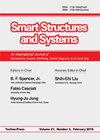为增加电缆机器人的工作空间增加了被动运输:民用基础设施表面的自动检查
IF 2.2
3区 工程技术
Q2 ENGINEERING, CIVIL
引用次数: 2
摘要
缆索驱动机器人是一种用驱动缆索代替刚性连杆的并联机器人。末端执行器由一组电缆支撑,这些电缆由通常放置在固定框架中的电机控制。通过改变电缆长度,可以改变末端执行器的位置和/或方向。电缆机器人的优点包括结构轻、能源效率高,以及由于电缆易于缠绕而能够覆盖大型工作空间。当不需要高速操作时,一个更安全的解决方案是设计电缆驱动的悬挂机器人,其中电缆张力的所有垂直分量都与重力方向相反。缆索驱动的悬挂机器人由于工作空间较高部分的扭矩要求较高,因此工作空间有限。在本文中,建议在框架顶部增加一个被动支架,从而实现比传统支架更大的可行工作空间,即具有与所需检查区域相同的尺寸,同时保持相同的电机要求。相反,这种新方案在末端执行器操纵过程中出现了不期望的振动。这些振动可以通过更复杂的控制策略来消除。本文建立了运动学和动力学模型。对传感器系统进行了分析,提出了控制末端执行器姿态的控制方案。仿真和实验结果表明,在控制末端执行器姿态的情况下,可行工作空间可以显著增加。这种新型的电缆驱动机器人可以很容易地应用于民用基础设施(如外墙或大坝)的大型垂直表面的自动检查和监测。本文章由计算机程序翻译,如有差异,请以英文原文为准。
Addition of passive-carriage for increasing workspace of cable robots: automated inspection of surfaces of civil infrastructures
Cable-driven robots are parallel manipulators in which rigid links are replaced by actuated cables. The end-effector is then supported by a set of cables commanded by motors that are usually placed in a fixed frame. By varying the cables length, it is possible to change the end-effector position and/or orientation. Among the advantages presented by cable robots are they light-weight structure, high energy efficiency and their ability to cover large workspaces since cables are easy to wind. When high-speed operation is not required, a safer solution is to design cable-driven suspended robots, where all vertical components of cables tension are against gravity direction. Cable-driven suspended robots present limited workspace due to the elevated torque requirements for the higher part of the workspace. In this paper, the addition of a passive carriage in the top of the frame is proposed, allowing to achieve a much greater feasible workspace than the conventional one, i.e., with the same size as the desired inspection area while maintaining the same motor requirements. In the opposite, this new scheme presents non-desired vibration during the end-effector maneuvers. These vibrations can be removed by means of a more complex control strategy. Kinematics and dynamics models are developed in this paper. An analysis of sensor system is carried out and a control scheme is proposed for controlling the end-effector pose. Simulation and experimental results show that the feasible workspace can be notoriously increased while end-effector pose is controlled. This new architecture of cable-driven robot can be easily applied for automated inspection and monitoring of very large vertical surfaces of civil infrastructures, such as facades or dams.
求助全文
通过发布文献求助,成功后即可免费获取论文全文。
去求助
来源期刊

Smart Structures and Systems
工程技术-工程:机械
CiteScore
6.50
自引率
8.60%
发文量
0
审稿时长
9 months
期刊介绍:
An International Journal of Mechatronics, Sensors, Monitoring, Control, Diagnosis, and Management airns at providing a major publication channel for researchers in the general area of smart structures and systems. Typical subjects considered by the journal include:
Sensors/Actuators(Materials/devices/ informatics/networking)
Structural Health Monitoring and Control
Diagnosis/Prognosis
Life Cycle Engineering(planning/design/ maintenance/renewal)
and related areas.
 求助内容:
求助内容: 应助结果提醒方式:
应助结果提醒方式:


